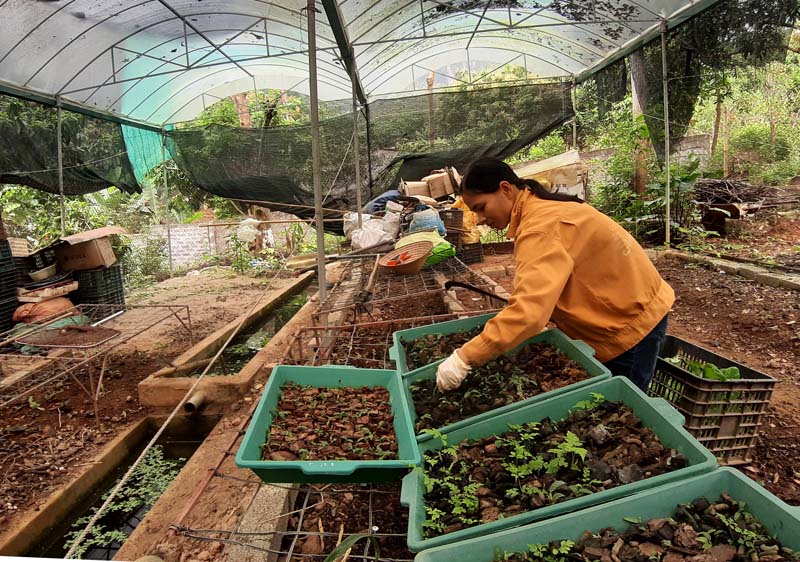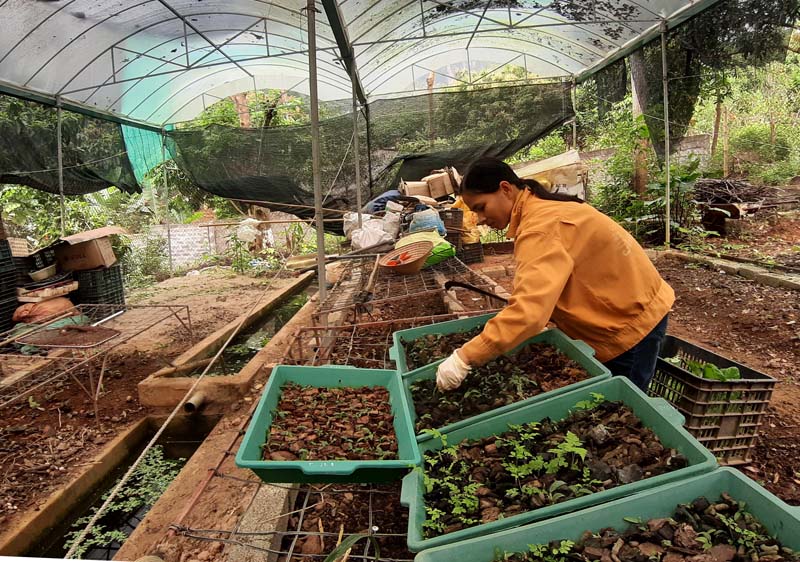
(HBO) – Hoa Binh province boasts relatively favourable natural conditions for growing medical herbs. Given this, a number of organisations and individuals have worked to develop large-scale medical herb farming zones, thus helping to provide jobs and raise income for locals.
 A
worker of the Biopharm Hoa Binh JSC examines medical herbs.
A
worker of the Biopharm Hoa Binh JSC examines medical herbs.
The Hoa Binh Medicine JSC, based in Hoa Son
commune of Luong Son district, specialises in growing, researching and
producing medical herbs, especially "xa den” (Celastrus hindsii Benth) which is
useful for health improvement. It carried out a scientific study which looked
into the chemical composition of the special herb and assessed the biological
activity of some compounds from this plant. The firm submitted its findings to
the authorised agency to seek a patent and is currently investing in a
production line. Some "xa den” derivatives have also been produced on a trial
basis.
Meanwhile, the INCA Vietnam JSC has coordinated
with relevant agencies and localities to create a sacha inchi growing area for
many years and reaped encouraging outcomes. Suiting the local mountainous
climate and soil conditions, the plant has developed well here and generated
relatively high economic benefits.
The growing area produced 1 – 1.3 tonnes of dry
fruit per ha in the first year and more than 3 tonnes since the third year,
with annual profit reaching 150 – 200 million VND (6,400 – 8,500 USD) per ha on
average.
INCA Vietnam said it plans to form a
concentrated sacha inchi farming zone in Hoa Binh and build a factory here to
process materials.
Via effective scientific research activities,
the Biopharm Hoa Binh JSC has successfully developed a cordyceps production
process and multiplied some available medical plants like ginseng, "thong dat”
(Palhinhaea cernua), "hoang tinh do” (Polygonatum kingianum Coll. et Hemsl.)
and "thong do” (Taxus wallichiana).
Hoa Binh boasts potential and advantages for
developing medical plant growing zones and producing medicines. In its plan on
developing medical herb farming areas until 2025, the province will focus on the
24 plants that it has strength in and cultivate them on over 2,800ha of land to
harvest about 14,000 – 20,000 tonnes of materials each year.
To that end, provincial authorities have been
assisting localities to convert ineffective farmland areas into those for
growing herbs in the long term, thus helping to improve the economic value on
the same farming area, create more jobs and raise income for locals, and
protect producers and consumers’ health and the environment.
Under the province’s instructions, localities in
Hoa Binh are reviewing areas zoned for herb farming, proposing support
policies, and inviting investment to medical herb cultivation and processing.
They are also building hi-tech production models, form connectivity between
producing and processing companies, and encouraging farmers to change crop
structures to develop concentrated medical herb growing zones./.
Since the beginning of this year, under the direction of the Department of Agriculture and Environment, the Sub-Department of Agricultural, Forestry, and Fishery Product Quality Management has strengthened the integration of the professional activities to promote and guide the organizations and individuals in the production and trading of agricultural, forestry, and fishery products to comply with the legal regulations regarding the use of chemicals, pesticides and veterinary medicines in crop cultivation, livestock farming and aquaculture. They also provide guidance to processing and manufacturing establishments on keeping the records to trace the product origins and using food additives from the approved list according to the regulations.
Hoa Binh province saw a significant rise in state budget revenue in the first two months of 2025, heard a meeting chaired by Vice Chairman of the provincial People’s Committee Quach Tat Liem.
Ha Thi Ha Chi, a 26-year-old graduate in law, has taken an unconventional path by returning to her hometown in Mai Chau district to establish the Tong Dau Cooperative, creating stable jobs for local women and bringing Thai ethnic brocade weaving to the global market.
As the Lunar New Year 2025 approached, pork prices surged, creating a profitable season for farmers in Tan Vinh commune, Luong Son district. Taking advantage of the rising demand, Can Minh Son, a farmer from Coi hamlet, sold over 30 pigs at 69,000 VND/kg, each weighing more than 100 kg. After deducting expenses, his family earned a profit of over 50 million VND.
alternate member of the Central Party Committee, Secretary of the Hoa Binh provincial Party Committee Nguyen Phi Long on March 5 had a working session with Yan Jiehe, Founder and Chairman of the China Pacific Construction Group, one of China's largest private corporations in the field of transport infrastructure. Deputy Secretary of the provincial Party Committee, Chairman of the provincial People's Committee Bui Duc Hinh and leaders of provincial departments and sectors also attended the working session.
The electronic printed circuit board (PCB) manufacturing and processing plant of Japan’s Meiko Group, located at Da River Left Bank Industrial Park in Hoa Binh city with a total investment of over 200 million USD, is expected to create thousands of jobs and make a significant contribution to the local budget.



 A
worker of the Biopharm Hoa Binh JSC examines medical herbs.
A
worker of the Biopharm Hoa Binh JSC examines medical herbs.